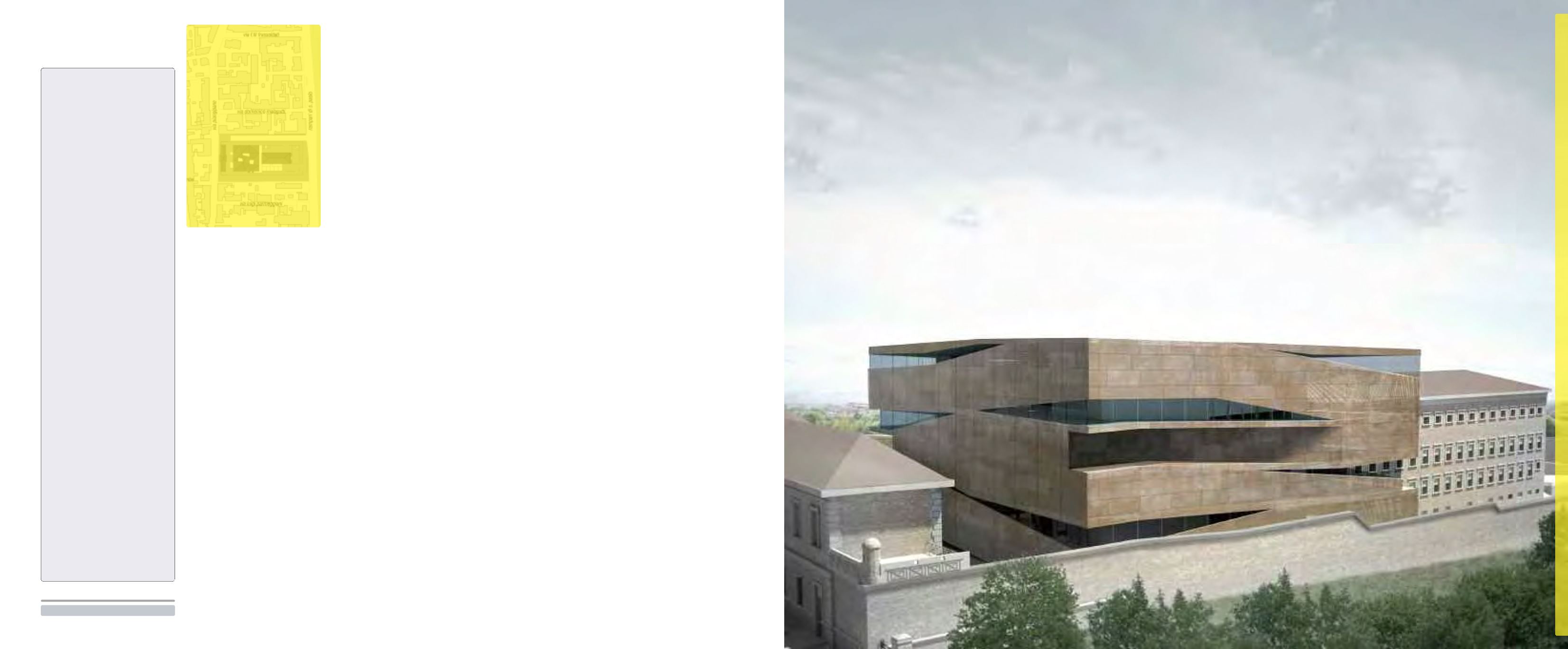
142
L’equilibrio tra queste istanze diverse
è delicato e difficile da mantenere.
Il progetto prevede che il percorso
di introduzione all’ebraismo si
svolga in tre volumi verticali, una
sorta di contenitori destinati a rac-
chiudere i cinque nuclei dell’iden-
tità ebraica – sinagoga,
bet
ha-midrash
, tribunale rabbinico,
ciclo della vita e delle feste, regole
alimentari ebraiche – mentre
quello dedicato alla storia ebraica
si sviluppi in una percorrenza eli-
coidale, che si svolge dal basso
verso l’alto, dall’antichità ai nostri
giorni.
Interpretando quanto previsto dal
bando, ovvero che i due temi –
quello storico e quello introduttivo
all’ebraismo – siano distinti, il pro-
getto struttura il museo intorno al-
l’ipotesi di due percorsi molto
differenziati, l’uno in verticale, l’al-
tro in una progressione lineare, ma
con numerose intersezioni (le pas-
serelle), che consentono di passare
dalla storia all’identità e dall’iden-
tità alla storia.
Il percorso identitario può essere
affrontato preliminarmente, op-
pure successivamente a quello sto-
rico, come approfondimento di
questo, oppure si può passare dal-
l’uno all’altro, una soluzione che
permette, nel passaggio tra sincro-
nia e diacronia, di ovviare al pro-
blema del nesso tra storia e
identità: vengono prima i fonda-
menti dell’identità o la storia?
Oppure i fondamenti sono conte-
stualizzati nel tempo, cioè nella
storia? Questa soluzione permette
The museum design
A museum exhibition on Jewish
Italian history encounters the type
of difficulties that are always met
in attempting to make a museum
object out of something that is real
and living. In the first place, the
defining characteristics of the Jews
as a culturally distinct people must
be described within their historical
context. In the second, there are
the difficulties inherent in
representing the actual historical
path: how Jewish history overlaps
with world history, including
periods of prejudice and anti-
Semitism. There is the task of
gathering historical knowledge
while questioning prejudices, the
necessity of avoiding victimization,
and scientific, ethical and civic
engagement.
The balance between these diverse
things is delicate and difficult to
maintain.
The project anticipates that the
path introducing Judaism will
unfold over three halls arranged
vertically, creating a kind of vessel
that will enclose the five nucleuses
of Jewish identity: the synagogue,
bet ha-midrash
, the rabbinical
tribunal, the cycle of life and
feasts, and Jewish dietary
restrictions. Meanwhile, the path
dedicated to Jewish history will be
shaped as a spiral that unwinds
from bottom to top, from antiquity
to modern times.
As specified in the competition
guidelines, the two themes, the
historical and the introduction to
Judaism, are distinct; therefore the
project structures the museum
around the idea of two separate
visits, one that unfolds vertically,
the other in a linear progression,
but with numerous intersections
(the catwalks) that make it easy to
pass from one to the other.
The path for Jewish identity may
be approached either before or
after the historical path, to deepen
understanding, or visitors may pass
from one to the other, so that by
moving between synchronicity and
diachronic difficulties of linking
history and identity are overcome.
Which comes first: the foundations
of history or identity? Or are the
foundations contextualized by
time, that is, by history? In
addition, this option makes it
immediately clear in a visual way
that Judaism is a present day
Il progetto del percorso
Un’esposizione museale della storia
degli ebrei italiani incontra le diffi-
coltà che sempre si pongono
quando si pretende di trasformare
in un oggetto da museo una realtà
viva e vitale: in primo luogo, la diffi-
coltà di spiegare la storia senza far
conoscere prima cosa sono gli ebrei
e, all’inverso, di delinearne i carat-
teri identitari senza collocarli prima
nel tempo e nelle trasformazioni in-
dotte dalla storia. In secondo luogo,
le difficoltà insite nel percorso sto-
rico vero e proprio: il rapporto della
storia del mondo ebraico con
l’esterno, quello con il pregiudizio e
l’antisemitismo, la necessità di evi-
tare il vittimismo, di sfatare luoghi
comuni consolidati, di mettere in-
sieme conoscenza storica e messa
in discussione del pregiudizio, scien-
tificità ed impegno etico e civile.
Capogruppo / Team leader
Cooprogetti soc. coop.
Gruppo / Team
Labics
Arch. Giovanni Manieri Elia
Studio Catalano
Tecnoengineering Srl
Progettisti /
Architectural designers
Labics (Arch. Maria Claudia
Clemente, Arch. Francesco
Isidori)
Arch. Giovanni Manieri Elia
Cooprogetti (Arch. Paolo
Ghirelli, Ing. Valter Fabio
Filippetti, Ing. Alessandro
Placucci, Dott. Fausto Pelicci)
Tecnoengineering (Ing.
Tiziano Volpi, P.I. Marcello
Cipriani)
Ing. Fulvio Catalano
Collaboratori / Associates
Edoardo Filippetti
Lorena Ragnacci
Fabio Balducci
Leonardo Consolazione
Billy Erhardt
Manuela Gentile
Dominique Rethàns
Consulenti / Consultants
Anna Foa
Fabio Massimo Iaquone


